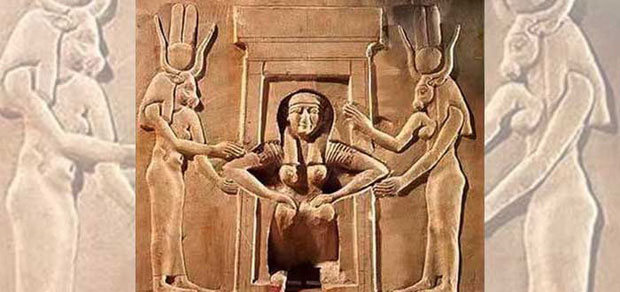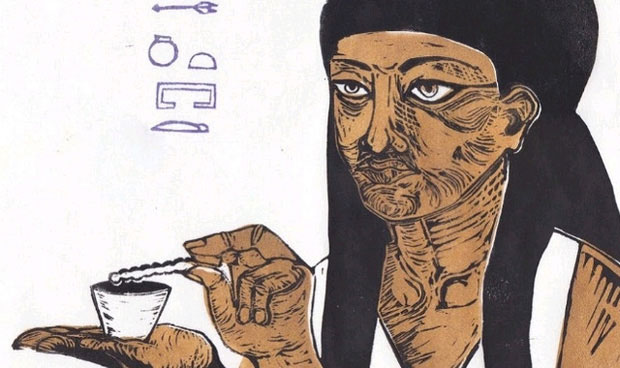The millennium-long medicine symbol of women from ancient Egypt may be just a 'trick'.
In recent decades, the scientific community has circulated the story of Merit Ptah. This is said to be a female doctor since ancient Egypt, living 5,000 years ago.
According to the story handed down, Ptah can be considered the first woman to be named in the history of human science, and become a symbol for women in pursuit of related professions.
The story is perfectly fine, except for one problem that experts have just discovered: Merit Ptah is unlikely to exist. In other words, the scientific symbol of women for a long time could be just a trick more.

The symbol of Merit Ptah.
Donkey symbol
Specifically, this is the conclusion of experts from the University of Colorado Anschutz (USA), led by Jakub Kwiecinski. The expert team traced the origins of the legendary Merit Ptah , and realized there were many irrationalities in this story. Accordingly, most of the details became confused about 80 years ago - the time Merit Ptah name appeared in public.
"The story of Merit Ptah is told everywhere. From forums for women pursuing science, then video games, history books . even Venus's volcano is named after her" - Kwiecinski said.
"But despite being talked about a lot, there is no evidence that she really exists. Things gradually become clearer as the historical document shows that there was no female doctor named Merit Ptah at the time. Ancient Egypt ".

There is no evidence that a female physician named Merit Ptah was in ancient Egypt.
It is known that the legend of Merit Ptah (the name means "loved by Ptah" ) originated in the early 20th century, originating from Kate Campbell Hurd-Mead - a Canadian physician and feminist. In 1938, Kate published a book on the history of women in medicine, including the legendary Merit Ptah.
"The first female doctor appeared in the Old Kingdom of Egypt, from 2730 BC, during the reign of Queen Neferirika-ra. Her son was a high-ranking priest, and his tombstone was inscribed. his mother with the title "Chief Physician" - cited in the book of Campbell Hurd-Mead.
In addition, the book mentions that "in the tomb in the Valley of the Kings (Egypt), there is a picture depicting the woman named Merit Ptah, the mother of a high priest and being His life of proclamation is the "Chief Physician", although there is no further data on his or her expertise and status.

True or false still cannot erase the fact that women were involved in academic research thousands of years ago.
However, Kwiecinski said both stories were problematic. First, the King's Valley was established at least 1,000 years later (1539 - 1075 BC). Secondly, there is currently no record of a doctor named Merit Ptah in the Old Kingdom of Egypt.
"That name was also not on the list of female executives of this period. There aren't any ancient tombs from the Old Kingdom that appear in the Valley of Kings - which should be the tomb of son of Merit Ptah. The tombs of this period are placed in a larger place, Theban Cemetery. "
And the twist is full of surprises
However, according to Kwiecinski, this does not mean that there were no female physicians in ancient Egypt. He found evidence of a female physician in the Old Kingdom, with many details that matched the story of Merit Ptah - except for the name. This man, Peseshet, is mentioned in the tomb of Akhethotep - her son and also a priest, living around 2400 BCE. Akhethotep's grave is located at the Saqqara cemetery.
In the tomb there are walls describing Akhethotep's father and mother. His father was an Egyptian official named Ptahhotep - meaning "the peace of the god Ptah" . Mother is Peseshet, with the title "Supervisor of female physicians".
A book in Campbell Hurd-Mead's personal library had a brief mention of Peseshet, so it was possible the doctor mistook her for the wife of Prime Minister Ramose. His wife, Merit Ptah, lived during 1350 BC and had a tomb in the Valley of the Kings.
"Unfortunately, when Hurd-Mead, when compiling the book, there was confusion about the name, era and tomb location of the female doctor" - Kwiecinski shared.
"And based on the story of a true female doctor, Peseshet, the legend of" the first female physician in history "was born.
Even so, the story of Merit Ptah, true or false, cannot erase the fact that women were involved in academic research thousands of years ago."Although Merit Ptah may not have been the first female physician and was a myth, she is still a symbol of how women tried to save history in science," concluded Kwiecinski. .
The research is published in the History of Medicine and Allied Sciences journal.
- Discovered 3,700 year old remains of women about to give birth in Egypt
- Ancient Egyptian women demanded benefits by marriage contracts
- 6 things we do not know about the people of ancient Egypt
- Mystery of ancient Egyptian symbols
- 6 interesting facts about ancient women that women themselves are surprised
- Decode the most classic symbols of the ancient world
- Homosexuality in ancient Egypt
- Wigs - Luxury beauty accessories for ancient Egyptian women
- Learn the disasters that destroyed ancient Egypt
- Feminism in ancient Egypt
- 3 everyday items you won't believe are from ancient Egypt
- Why did the ancient Egyptians worship lotus images?
 Discovered an ancient centipede fossil 99 million years old
Discovered an ancient centipede fossil 99 million years old Discovered bat-like dinosaurs in China
Discovered bat-like dinosaurs in China Discovered a 200-year-old bronze cannon of the coast
Discovered a 200-year-old bronze cannon of the coast Discover 305 million-year-old spider fossils
Discover 305 million-year-old spider fossils